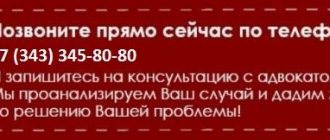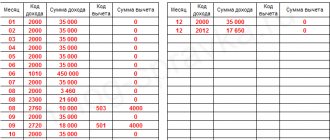How to calculate VAT including
Calculating VAT as well means highlighting the tax that is included in the final amount. Here the formulas are used for calculation:
VAT = C / 120 × 20 - if you need to calculate VAT 20% (from 01/01/2019),
VAT = C / 118 × 18 - if you need to calculate VAT 18% (until 01/01/2019),
VAT = C / 110 × 10 - if the tax rate is 10%,
Where: C is the amount including VAT.
See also “ What is included in the list of goods subject to VAT at a rate of 10%? »
ATTENTION! This calculation does not mean applying estimated rates of 20/120 (18/118) or 10/110 - it is simply a way to separate the tax from the total.
Read more about settlement rates in this article .
How to calculate VAT (20%) for legal entities using a calculator
Are you a representative of an organization or an individual entrepreneur and want to understand how to calculate the amount with VAT in order to include the tax in the final price of a product or service, or find out how to separate VAT from the amount? Using an online tool makes this extremely easy. To use the online VAT calculator, you only need to do one thing: enter the number in the line.
The selected and accrued tax and the amount of sale or purchase with and without tax will appear on the right.
Since some goods are taxed at a rate of 10%, the value in the “tax rate” line can be changed; the VAT calculator generates a value taking this rate into account.
The correct totals will immediately appear in the fields on the right.
Example of VAT calculation
Using the above formulas, we will analyze how to correctly calculate VAT (in excess of the amount, including), using examples.
Example 1
LLC "X" sells a batch of concrete blocks in the amount of 100 thousand pieces. at a price of 55 rub. a piece. The VAT rate is 20% (clause 3 of Article 164 of the Tax Code of the Russian Federation), tax is not included in the price. How to calculate VAT 20% and the final cost of the shipment including tax?
- First, we determine the cost of the batch without VAT (tax base):
55 rub. × 100,000 pcs. = 5,500,000 rub.
- Let's calculate VAT from the amount:
5,500,000 × 20/100 = 1,100,000 rub.
- Let's calculate the amount including VAT:
5,500,000 + 1,100,000 = 6,600,000 rub.
- Or you can determine the total amount immediately, without first calculating the tax:
5,500,000 × 1.20 = 6,600,000 rub.
Accordingly, the following must be indicated in settlement documents and invoices:
- cost without VAT - 5,500,000 rubles,
- VAT 20% - RUB 1,100,000,
- total including VAT - 6,600,000 rubles.
Example 2
According to the price list of X LLC, the price of a curbstone including VAT is 240 rubles. for 1 piece The buyer ordered a batch of 10 thousand pieces. Let's calculate VAT 20%.
- First, let's determine the final cost of the batch:
240 rub. × 10,000 pcs. = 2,400,000 rub.
- We will calculate VAT including:
2,400,000 / 120 × 20 = 400,000 rub.
- The amount remaining excluding VAT:
2,400,000 – 400,000 = 2,000,000 rub.
It can also be found without prior allocation of tax:
2,400,000 / 1.20 = 2,000,000 rub.
You can check the correctness of the calculation by charging VAT on the received value without tax:
2,000,000 × 20/100 = 400,000 rub.
Accordingly, the following must be indicated in settlement documents and invoices:
- cost without VAT - 2,000,000 rubles,
- VAT 20% - 400,000 rubles,
- total including VAT - 2,400,000 rubles.
For information on how to reflect the calculated VAT amount in the declaration and in accounting, see the Ready-made solution from ConsultantPlus.
What is a VAT deduction?
At first glance, since VAT must be charged on the sale of goods, works, and services, it is no different from sales tax (turnover). But if we return to its full name - “value added tax”, then it becomes clear that not the entire sales amount should be subject to it, but only the added value . Added value is the difference between the cost of goods, works, services sold and the costs of purchasing materials, raw materials, goods, and other resources spent on them.
This makes clear the need to obtain a VAT tax deduction. The deduction reduces the amount of VAT accrued upon sale by the amount of VAT that was paid to the supplier when purchasing goods, works, and services. Let's look at an example.
Organization “A” purchased goods from organization “B” for resale at a cost of 7,000 rubles per unit. The VAT amount was 1,400 rubles (at a rate of 20%), the total purchase price was 8,400 rubles. Next, organization “A” sells the product to organization “C” for 10,000 rubles per unit. VAT on sales is equal to 2,000 rubles, which organization “A” must transfer to the budget. In the amount of 2,000 rubles, the VAT (1,400 rubles) that was paid during the purchase from organization “B” is already “hidden”.
In fact, the obligation of organization “A” to the budget for VAT is only 2,000 – 1,400 = 600 rubles, but this is provided that the tax authorities offset this input VAT, that is, provide the organization with a tax deduction. Receiving this deduction is accompanied by many conditions; below we will consider them in more detail.
In addition to deducting VAT amounts paid to suppliers when purchasing goods, works, services, VAT on sales can be reduced by the amounts specified in Article 171 of the Tax Code of the Russian Federation. This is VAT paid when importing goods into the territory of the Russian Federation; when returning goods or refusing to perform work or provide services; when the cost of shipped goods (work performed, services provided) decreases, etc.
Rules for filing a VAT return in the Russian Federation and Ukraine
At the end of the reporting period, each enterprise registered with the tax office submits a VAT return. For “dummies”, we note: in Russia, the reporting period is considered a quarter, and in Ukraine – a month. The quarterly reporting period is used only if the volume of taxable transactions for the last 12 months does not exceed the amount of UAH 300,000. Within twenty days following the last day of the tax period, the declaration must be submitted to the relevant authorities. Payment of contributions in Ukraine must occur within thirty days after the end of the reporting period, and in Russia - within twenty.
Filing a tax return in Ukraine can be carried out personally by the taxpayer, transmitted electronically or sent by mail as a valuable letter with mandatory notification. In Russia, as of January 1, 2014, VAT returns can only be submitted electronically via telecommunications channels. You can select an electronic document management operator on the regional websites of the Federal Tax Service. It is necessary to conclude an agreement with him, obtain crypto-protection means and an enhanced qualified electronic signature, which will be used to certify invoices and declarations.
Filling out the VAT return must be carried out in strict accordance with the form established on the date of its submission.
How is VAT payable to the budget calculated?
If you remember the advertisement, unpaid taxes interfere with a restful sleep. But this is not the worst thing - failure to fulfill one’s obligations to the state is fraught with heavy fines for entrepreneurs. In order to transfer VAT and income tax to the budget, you must first determine the profit from sales and a number of other indicators. Let us dwell in more detail on how to calculate the VAT that must be paid to the budget.
Important: the tax period for value added tax payers is a quarter, and the deadline for submitting a VAT return is the 25th day of the month following the reporting period (quarter). For example, for the 4th quarter of 2020, you should report no later than January 25, 2020. If the 25th falls on a weekend, then the declaration can be submitted on the first working day following the reporting day. Although, of course, you shouldn’t leave everything to the last minute.
VAT is paid to the budget, equal to the difference between the accrued value added tax (on those goods and services that were sold, or on the prepayment received for them) and VAT accepted for deduction (calculated on the basis of receipt documents reflecting the organization’s purchase of goods and services ). The formula looks like this:
VAT payable to the budget = Accrued VAT – VAT deductible.
If the calculation results in a negative number, then the company has the right to claim a VAT refund from the budget. However, you must keep in mind that the return of funds will involve a number of checks.
See also: What is targeted training on labor protection and how to conduct it
Calculations at a reduced rate
There should also be no problems in calculating VAT at a rate of 10 percent. The formula to be applied is absolutely identical to that for 18 percent. The only difference is that in place of the tax rate you need to put a “ten”.
Therefore, if the task is how to calculate VAT at a rate of 10%, we offer the formula:
S × 10% = VAT As in the previous case, S – here also means the total amount of goods sold, works or services owned by the company. And it also does not initially take into account value added tax.
Let's give a more clear example of how to calculate VAT from the transaction amount.
EXAMPLE
The total amount of goods, services or work sold by a merchant is 70 thousand rubles. Applying the formula, that is, multiplying this figure by 10 percent, we get an amount equal to 7 thousand rubles. This will be the final tax amount. As you can see, calculating VAT is not difficult at all.
Calculation
VAT accounting for dummies begins with recording invoices in the sales ledger and purchases ledger. The difference between the tax liability and the total amount of tax credit for the reporting period is VAT payable. If you carefully keep your accounting records, it is very easy to calculate VAT. For “dummies”, postings can be very complicated, so the entries should be made by a professional, since they are the basis for the final tax calculation at the end of the reporting period.
The value added tax rate depends on the activities carried out by the enterprise, as well as on its annual cash turnover. Let us explain the calculation of VAT using the example of the production and sale of women's dresses in the Russian Federation, for which VAT is 18%. The manufacturer purchased fabric and accessories in the amount of 20,000 rubles, and also paid VAT of 3,600 rubles. He received an invoice, which he entered into the purchase ledger. 3600 rub. – this is a tax credit in this case.
10 dresses were produced from the original materials, which are planned to be sold at a price of 3,500 rubles. each, that is, the total markup on the product will be 15,000 rubles. The tax liability is calculated as follows: (3500*10)*18/100=6300 rub. The formula for mandatory VAT payment for a “teapot” is simple: a tax credit is deducted from the tax liability. In our example, you need to do the following: 6300-3600 = 2700 rubles. The entrepreneur must pay VAT in the amount of 2,700 rubles, since 3,600 rubles. he already contributed when he purchased the fabric and accessories.
Tax rates in the Russian Federation
VAT for dummies (2014) is 3 rates: 0%, 10% and 18%, determined depending on the type of activity of the enterprise. A 0% value added tax is imposed on the sale of the following goods, services or works:
- Obligations fulfilled by organizations for pipeline transport of petroleum products and natural gas.
- Services for international transportation of goods.
- Provision of railway rolling stock.
- Sales of goods exported under the customs export procedure.
The full list of taxation objects is set out in Art. 164 Tax Code of the Russian Federation. VAT of 10% is paid on the sale of food products:
- meat, poultry, seafood, fish;
- eggs;
- salt, sugar;
- grains, cereals;
- pasta;
- dairy products;
- bakery products;
- vegetables;
- children's and diabetic nutrition.
10% is charged when selling the following children's goods:
- clothes and shoes;
- beds and mattresses;
- diapers;
- strollers;
- office supplies.
Book products of an educational nature related to science or culture, as well as periodicals are subject to VAT of 10%. This does not apply to printed products of an erotic or advertising nature. Medical goods: drugs and medical products are also among the goods subject to VAT at 10%.
In all other cases, a tax rate of 18% applies. If we are talking about goods imported into the territory of the Russian Federation, they are subject to a value added tax of 10% or 18%.
What is an invoice?
This document contains information about the price of the product excluding VAT and the total cost including VAT. This document must be provided by the supplier, and it must be filed in a special accounting journal and noted in the sales book.
The main difficulty in maintaining an invoice is that the responsibility for issuing it rests largely with the counterparty with whom the taxpayer cooperates. And if he fills something out incorrectly, during the inspection the inspector may cancel the deductions and additionally charge VAT. Therefore, a counterparty’s mistake may result in additional expenses for the taxpayer. This means that you need to require the supplier to accurately fill out documents.









